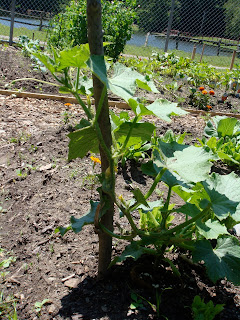Everything is doing merrily in the garden, though it is getting hot, hot, hot for a gnome! If you don't see me when you come visit, I've burrowed deep into the soil to keep cool.
Last year, excessive rainfall caused many tomato plants in the Northeast to catch late blight- hopefully that won't be a problem this year for our cherry tomatoes. However, just in case- here are some tips to gardeners everywhere on avoiding late blight- from my gnome friends at Cornell:
10 tips to prevent late blight in home gardens
* Kill volunteer potatoes. Dig up, bag and trash any volunteer potato plants that pop up in gardens or compost piles. It may take repeated efforts to get them all.
* Use only certified seed potatoes. Don't use leftovers from last year or table stock from the grocery store.
* Buy healthy tomato plants. Learn what late blight looks like. Report any infected plants while shopping or grow your own plants. (Late blight isn't spread on tomato seeds.)
* Keep plants dry. If plants need watering, water the soil -- not the foliage.
* Inspect plants at least once a week, more often if weather is cool and wet. Immediately remove and bag any foliage you suspect might be infected.
* If symptoms continue despite removing infected foliage, consider removing plants entirely -- sooner rather than later. The longer you wait to remove plants, the more spores will be blown to other gardens and farms.
* Warn neighbors and local Cooperative Extension if you find late blight in your garden.
* Remove infected plants during the middle of a sunny day after leaves have dried. But don't wait for these conditions. Seal plants in garbage bags and leave them in the sun for a few days to kill plants and the pathogen before placing in the trash or burying underground or deep in a compost pile.
* Keep an eye on other tomato-family plants. Some strains of late blight can infect other tomato-family plants, including weeds such as hairy nightshade and bittersweet nightshade. Control them early so that late blight on these plants doesn't go unnoticed. Petunias and tomatillos are also vulnerable to attack.
Craig Cramer is communications specialist in the Department of Horticulture at Cornell.
 Sweet Basil
Sweet Basil

















